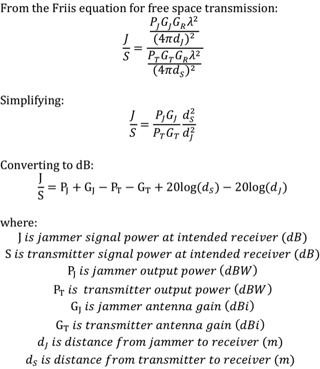Electronic warfare is making the news a lot lately. Not only do our adversaries employ, or seek to employ, sophisticated capabilities, the US Third Offset advocates the deployment of even more advanced technology and EW techniques to maintain superiority over near-peer actors.
Radio Frequency Jamming
Radio frequency jamming is one of the most recognized EW methods; but how does it work, anyway? Discover, by way of example below, that just a few parameters rule the jamming game!
Let's concentrate on the ground, in the dusty areas of the world where way too much conflict exists -- and modern commercially available technology raises our asymmetric foe's confidence. Everybody loves new gadgets like drones and smartphones; they can be dangerously amazing -- but vulnerable.
Signal Jamming Example
Say you want to advance on a remote compound whose occupants protect it with quad-copter surveillance and communication to perimeter guards by smartphone messaging via gotenna off-grid transceivers, as depicted in the graphic below.
 With wide open fields surrounding the compound, you'll likely be spotted by the eye in the sky. So to enhance operational surprise, jamming communications between the command hut and sentry posts is key. This is where the physics comes in.
With wide open fields surrounding the compound, you'll likely be spotted by the eye in the sky. So to enhance operational surprise, jamming communications between the command hut and sentry posts is key. This is where the physics comes in.
Grossly oversimplifying, it's all about RF signal and noise: specifically their ratio. The gotenna units operate in VHF (around 150MHz), with 2 watt radios and about a -5 dBi omni antenna signaling a proprietary waveform that can purportedly deliver 4 miles of comms range to another gotenna device in open, flat conditions (in the presence of typical RF noise). Such conditions create favorable signal (S) to noise (N) ratios (typically stated in dB).
J/S Ratio
To effectively jam a signal it is necessary to create noise at the target receiver (let's call it J) greater than the communications signal -- thus the jam-to-signal ratio (J/S) is born. Note J/S is the inverse of S/N, with jamming noise J replacing more typical environmental noise N.
Since most transceivers need S/N ratios of several dB to work tolerably, even a J to S of one (0 dB) can effectively disable the receiver's ability to decode the signal.
So how would you actually do this in our scenario above? We'll have to delve into the math just a bit. Because the communications and jamming transmitters are not the same, and at different locations, we have to account for the following variables: transmission distance between each transmitter and the target receiver, as well as the RF output power and antenna gain of each transmitter.
 You can see from the equations above that only transmitter characteristics and distance matter for winning the jamming game.
You can see from the equations above that only transmitter characteristics and distance matter for winning the jamming game.
Using the values from the graphic above (i.e. the portable jammer has a 5 watt transmitter with unity gain omni antenna), and distances of 100 meters between transmitter and receiver and 300 meters from jammer to receiver, our J/S would be:
J/S = 7 + 0 - 3 - -5 + 40 - 50 = -1 dB
In this scenario, 300 meters is right at the edge of where the portable jammer and gotenna would compete head to head for signal or 'noise' supremacy at the target receiver. Considering this rather close distance from a safety perspective, you may consider the employment of a fixed jammer with higher output power and a directional gain antenna to get more radiated power down-range.
A 4 dBi antenna connected to a 30 watt transmitter at one kilometer range produces J/S of 1 dB at the receiver. A nice overlay of additional protection for the portable jammer at extended distances. Of course, when the portable jammer is near the perimeter it will dominate despite its lower power and gain... shorter distance wins now.
Relevant Products
If you're wondering what jamming antennas would be good for this mission, check out these manpack omnis: WB1318, WD1350Q, and this portable wire log periodic: LPDA-A0097.
Want to learn more about how our portfolio of jamming and counter-RCIED antennas can benefit your system integration? Contact me, and jam on!

